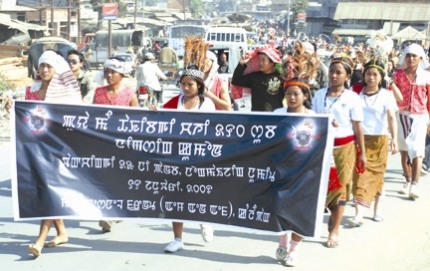Imphal, January 19: MANIPUR SUNDAY remembered "Puya Mei Thakhiba, an event in the early 1700's in Manipur which involved the burning of the indigenous Meitei scripts or Holy Books" to mark the 280th anniversary of the historic event marking the end of the Sanamahism, original religion and arrival of the Hinduism.
It was on this day in 1729 that Puya, the books written in indigenous Meitei Script including sacred and history of more than 3000 year old civilization of Manipur, the then kingdom of Kangleipak, were set ablaze by the king Garbaniwaj with the advised of the Hindu priest Shantidas Gosai spreading Hinduism in the region.
It was on this day in 1729 that Puya, the books written in indigenous Meitei Script including sacred and history of more than 3000 year old civilization of Manipur, the then kingdom of Kangleipak, were set ablaze by the king Garbaniwaj with the advised of the Hindu priest Shantidas Gosai spreading Hinduism in the region.
|
The event had also marked the vanishing of the original scripts of the land and replacing it by the Bengali scripts.
This superimposition of the foreign Hindu religion and culture resulted in a cultural dichotomy and created different social structures and institutions predominated by the Hindu caste system with its 'untouchables' concept which is totally alien to Manipuri culture, according to the scholars.
A massive rally participated by hundreds of people from different ethnic groups settling in the state across the state was also marched on the street to marked the occasion.
The rally passed through the historic Kangla Fort located in the heart of the Imphal city where kings rule the people since time immemorial.
The rally organized by the National Front (MNF) Kangleipak kicked off from the Royal Palace at Palace Compound, Imphal at around 11 am.
It was flagged off by the titular king of Manipur, Sanajoaba who still living in the royal palace and taking part actively in preserving the cultural tradition of the people of the state.
The titular king also attended as chief guest in a function held at Hapta Kangcheibung.
Speaking on the occasion, Sanajaoba said that the burning of puya has also affected the relation between the people of hill and valley in the state.
He also called the people to preserve the left out puya which kept concealed by the forefathers.
Former minister RV Minthing who also attended the function recounted and said that puya has guided the people of both hill and valley and when hill people wanted to know the futures in the olden time use to go to valley and read the puya to estimate the possible future happening.
L Lhouvum Shatkho Thadou said that when a holy books of a land be burned down with the advise of an alien who will be happy.
The burning down of the books is a irreparable loss of the people of Manipur whether in the hill or valley.
The function was also attended by RV Minthing, retired IGP, Abdul Rehman, advisor, Motbung village L Lhouvum Shatkho Thadou, President Khongbal Khamenlok Area Development Committee L Katul, Naoriya Amusana hailing from Heilankandi Laishram Khul (Jaribond), advisor MNF Moirangthem Naodalenkhomba, Tokpam Thawaileima, retired principal DMC of Commerce, member Kangla Forth Board, Sairem Nilabir, Deputy director Manipur State Academy, Ningthou, Maram Centre, K Taruba, former chief, Echum Kom Keirap, Luthatson Kom, Ningthou, and Purumchumbam Chothe, Komlathabi, Y Maipakchao Chothe.
Many other chiefs of hill villages like the headman of Sadhu Koireng, Ngirel Koireng, S Renaichung Purum, chief of Purum Likli, Henboi Misao, organizer, Women and child development K Abung Thangal, former chief of Thangal Surung, Yensenbam Thoungamba, advisor Moreh Meetei Lai Thangal Kanglup, Sathang Haokip, social worker from Churachandpur S Sokhel Thangal chief of Longa Koireng Dr TB, senior lecturer, Oriental College, Chana Lukhoi script writer, TM Rajem Ayangba, president Malem Leisemkol, Kangla, Hamom Dhani, advisor Umang Lai Thoungal Lup also among other who attended the function.
Titular king Sanajaoba also presented this year's "Maichou Ningsing Mana" to Naorem Amusana son of late Phlo and "Chingtam Tammi Nungshi Khudol Mana", to Shatkho Thadou.
The awards are instituted by the MNF, a body working for preserving the culture of the people of different communities residing in the state.
According to a leaflet distributed to the people on the occasion, the organizers stated that the burning of the "Puya" book also marked the beginning of the loss of sovereignty of the people of Manipur which the kings protected for more than 3000 years.
"Before the advent of Hinduism in Kangleipak, Burma was a good friend of Kangleipak.
Six devastations beginning in 1755 A.D., seven years after the Downfall of king Pamheiba Garivaniwaz, left Kangleipak a pauperized country unable to stand itself," an article written by the President, Kangleipak Historical and Cultural Research Centre, Wangkhemcha Chingtamlen said.
Sanamahism, the indigenous religion still follow by a few section of the people, is the worship of Sanamahi, the Creator aspect of Sidaba Mapu, the trinity God of the Meiteis.
Sanamahism is one of the oldest sects of South Asia.
It originated in Manipur India and is mainly practiced by the Meiteis, Kabui, Zeliangrong and other communities who inhabit Manipur, Assam, Tripura, Uttar Pradesh, Myanmar and Bangladesh, with small populations in the United Kingdom, United States, and Canada, scholars speaking at the function held at Hatta Kangcheibung said.
According to the last census, about eleven percent of Manipur belong to religions stated as 'other'.
Most of this population can be assumed to represent followers of the Sanamahi religion.
This represents a significant increase over the previous census.
The revivalism of Sanamahism is recognized by the census records of the government of India due to the praise worthy efforts of late R..KBirendro Singh, I.A.S.Attitude of indigenous people of Manipur to the religion and concept of God is not possible without the proper understanding of Sanamahi religion.
Pakhangba Laining was also currently employed to signify revivalism, scolars in Manipur wrote in various article of "puya".

No comments:
Post a Comment